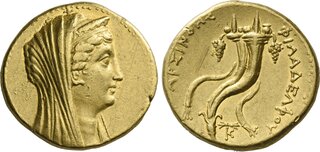Lot description:
Ptolemy II Philadelphos, 285 – 246.
In name of Arsinoe. Octodrachm, Citium circa 253-241, AV 28 mm, 27.71 g. Head r., veiled and wearing stephane; lotus-tipped sceptre in background. Rev. APΣINOHΣ – ΦΙΛΑΔΕΛΦΟΥ Double cornucopiae filled with fruit and bound with fillets; in field below, thunderbolt upon K. Svoronos 523 and pl. XV, 5. CPE 489 (these dies).
Extremely rare. Marks in fields and on edge, possible traces
of mounting, otherwise good very fine
From the collection of a Mentor.
When Arsinoe II, the sister-wife of King Ptolemy II, died in July, 270 B.C., a new cult was established in her honour as Thea Philadelphus ('brother-loving goddess'). This was distinct from the Theoi Adelphoi ('sibling gods') cult, which by 272/1 had been established for her and her husband. The first honorary coinage for Arsinoe II and her new cult were magnificent silver decadrachms that appear to have been issued soon after her death. Starting in about 261/0, the same types were then employed for gold coins that must have been as impressive then as they are to today. The largest of these was an octodrachm or mnaieion (one-mina piece) that appears to have been worth 100 silver drachms. Gold in the name of Arsinoe was produced for nearly 150 years, over which time the engraving style changed significantly. The earliest pieces, from the mid-3rd Century under Ptolemy II and Ptolemy III, are of fine style, and the later ones – though boldly struck in high relief with reflective, proof-like fields – are of a distinctly lower tier of artistry. The portrait on the last of these coins has a bulbous, almost comical character. Throughout the series, the principal mint for the gold was Alexandria. Its issues often have control letters behind the veiled head of Arsinoe, but no symbols on the reverse. Mints in Phoenicia, Palestine, and Cyprus also contributed to the series, with their products being distinguished by certain aspects of style and fabric, and by the presence of Greek letters and/or monograms in the reverse field which identify the mint, and sometimes the date of issue. The Syro-Phoenician issues of Tyre, Sidon, Ake-Ptolemais, Joppa, and Gaza bear dates according to the regnal years of the issuing monarch. Those of the Cypriot mints of Salamis, Citium, and Paphos are undated. We may add to these a somewhat irregular issue from Ephesus that seems to have been struck under Ptolemy III.
Estimate: 5000 CHF |  |